-
Posts
6,486 -
Joined
-
Last visited
-
Days Won
10
Content Type
Profiles
Forums
Blogs
Gallery
Events
Store
Posts posted by Brian Wolfe
-
-
Hello Brian, I am really out of my league here as I am just starting to become interested in this stuff. Based on the stamping TP-T I would gather it is a tank projectile. In fact I think this is the projectile that fits with the 105mm casing I was researching. The Brass case I have is for a Leopard 1, the case is dated 1070 and has the British Broad Arrow stamp on it. If I may suggest, post this over at BOCN or if you are not a member, with your permission, I can post it there.
Again, as I said, I am just starting to learn about these things.
I am not a member there and if you wouldn't mind posting it on the BOCN I would greatly appreciate it, thanks Pylon1357.
Regards
Brian
0 -
Hi Ian,
Thanks for posting the additional items. I have never seen the PAMS badge, very nice. I have a short article from a magazine regarding the Staffordshire auxiliary messenger service that I will post some day. I need more hours in my day!
Regards
Brian
0 -
Very nice medal and great research.
I've alway liked Edward VII medals but the bank account just won't stand me collecting everything I like.
I for one look forward to reading more.
Regards
Brian
0 -
Excellent sword as well as the collection and the research is so complete.
Well done.

I especially like items that span time periods, Victorian to Edwardian as in this case as well as Geo V to Geo VI etc. This post was a most enjoyable read on my last day of my vacation.
Thanks for taking the time to post this interesting topic.
Regards
Brian
0 -
Funny, I was looking about the net the other day fro information on a 105mm brass casing I have. I came across a projectile like this, but I can not find it again.
It is a HEAT High Explosive Anti Tank projectile.
MWC is the manufacturer. But I can not recall the name nor the site I was at. 1-18-1974 is the date of manufacture, January 18 1974.
TP-T If I recall is Training Projectile Tank.
Thanks Pylon. I could not figure out what the TP-T stood for but as usual once it is pointed out it becomes so clear.
 I would have never thought about MWC being the initials of the manufacturer. Do you know if these were fired by a tank or from an artillery piece? Also would any 105mm casing from the same time period be correct to display this prijectile in or was there somthing "special" about the casing for this particular round?
I would have never thought about MWC being the initials of the manufacturer. Do you know if these were fired by a tank or from an artillery piece? Also would any 105mm casing from the same time period be correct to display this prijectile in or was there somthing "special" about the casing for this particular round?Thanks again.
Regards
Brian
0 -
Sorry Brian - you may be a friend, but quite honestly I wouldn't want you in the same office with a mortar bomb .....
Oh fine, play with a little high explosive device and your friends desert you. Well...the smarter friends anyway.


Brian
0 -
What an interesting way to display a collection.
Makes my display methods look...well...uninteresting to say the least, and she sings?

Regards
Brian
0 -
Rick you have no idea. If I tell one more joke about scraping an endangered species off my boot I think I'll be sacked.

Talk about a group that needs to lighten up.
Regards
Brian
0 -
Here are the markings.
MWC-1-18-1974 105MM TP-T
Thanks again for your help.
Regards
Brian
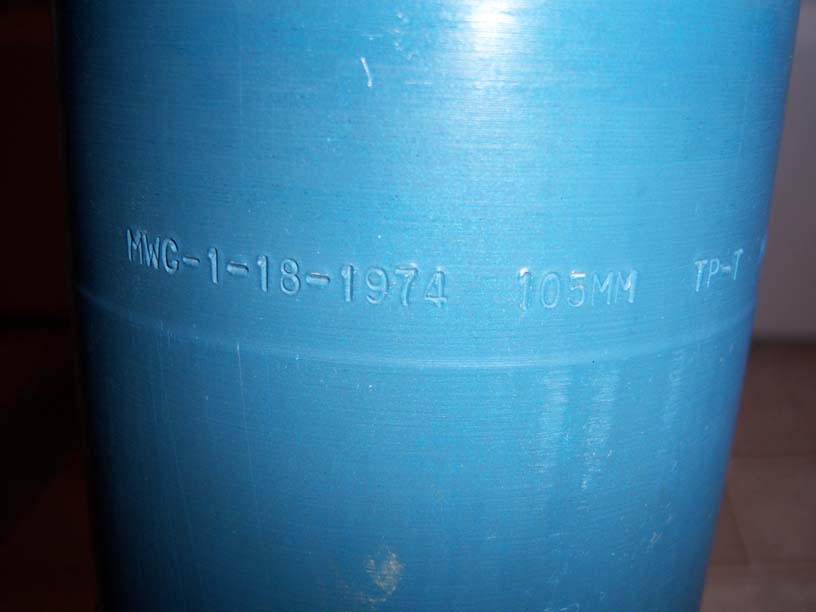 0
0 -
Hello everyone,
First let me explain that I work for a quasi-governmental body where for some reason security is extremely tight and my coworkers have no sense of humour regarding most of what I am about (military interest)
 . A week ago the item which is the subject of this post showed up on my desk. I had been expecting it to be there as another empolyee was getting rid of it and I said I'd take it off his hands. As you can imagine there was quite a stir in the office at the sight of this ordance, albeit inert.
. A week ago the item which is the subject of this post showed up on my desk. I had been expecting it to be there as another empolyee was getting rid of it and I said I'd take it off his hands. As you can imagine there was quite a stir in the office at the sight of this ordance, albeit inert. 
Anyway, it's a 105mm round and from my searches on the internet it looks like it is meant to be mounted in an artillery shell of some sort. The ones I found were H.E.A.T. rounds which I think stands for High Explosive Anti Tank round. It weighs 20 pounds and is 26 inches long. I am hoping that some of the members can help me with more information on this round. I think the only stampings show up quite well in the second photo.
Oh yes, the office settled down after I took the "bomb" to my truck.
God, it's going to be a long time until retirement!

Thanks for any information you can give me.
Regards
Brian
 0
0 -
In keeping with the last post regarding the Para R. here is my offering.
This group was awarded to:
IB522059 PTR. R. KUMAR
His medals are as follows,
Vishesh Seva Padak/Special Service Medal: Absent
Op Parakram Medal: Absent
Sainya Seva Medal: Absent
Ucchh Tungta Medal/High Altitude Medal: Absent
50th Independence Anniversary Medal: IB522059 PTR. R. KUMAR
PTR. = Paratrooper
This group arrived from India court mounted and is an official mounting.
It has been common in resent times for the soldiers to wear their medal ribbons mounted in this way even if the medals have as yet not arrived. There are several photos of soldiers in dress uniform wearing such mounts. I would post a photo to make my point but I do not have permission to post them and they are copy righted.
What we can tell about this paratrooper from his medals is as follows. We know from the High Altitude Medal he was serving after 1986 and that he served in the High Himalayas and that would make me think that the Sainya Seva Medal probably had the Himalaya clasp. The Special Service Medal only comes with two different clasps and I would think this would have had the Suraksha clasp as that was for security service in the Punjab as well as other areas of northern India, besides the other clasp is for Sri Lanka. The 50th Independence Anniversary Medal shows he was serving in 1997 in order to qualify to receive it. Last is the Op Parakram Medal for service during the military build up along the India/Pakistan border. This action took place from 2001 to 2003 with demining operations taking place into 2004. The absence of a 9 Years Long Service Medal would make me think he joined up in 1992 or after.
Regards
Brian
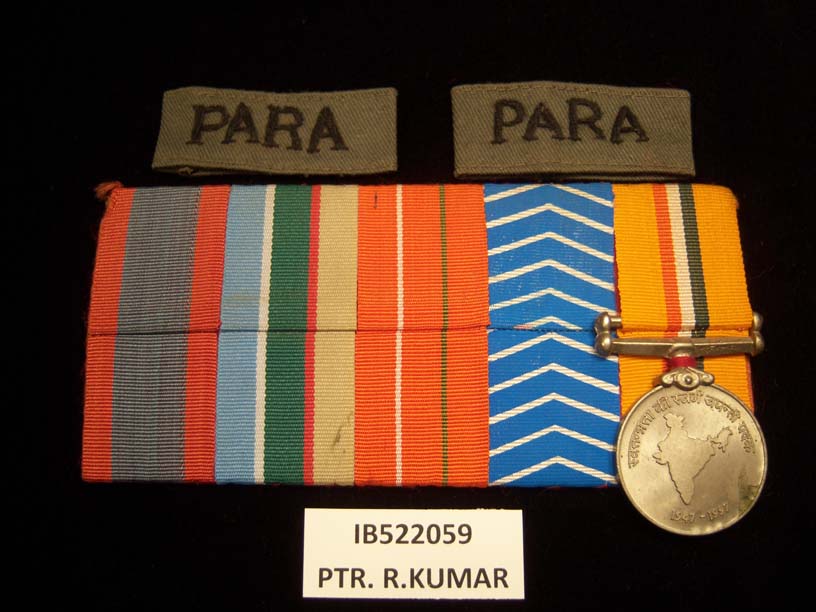 0
0 -
Hi Everyone,
This is one a the new groups i have just gor today


 .It's a pair to the Indian Army Parachute Regiment
.It's a pair to the Indian Army Parachute Regiment  .
.1, Raksha medal to 13602139 ptr Gurnam Singh Para R
2, Sanya Seva with Himalaya clasp to 13602139 ptr Gurnam Singh Para R
Nice to have medals to the Para, I look forward to seeing them in future posts.
Regards
Brian
0 -
This is a Special COnstabulary brassard from the First World War period worn by the Wolverhampton Police Service. Wolverhampton is now in West Midland County but during the Great War it was in Staffordshire. The change of municipal jurisdictions took place in 1974.
The brassard is 64mm in diameter and 79mm wide including the belt loops. The leather belt, or strap, is intact with the buckle though I did not include it in the photo. This brassard was made by Hiatt & Co. B'han as are the other aluminum brassards in my collection. I see from the photos it could use yet another cleaning, it looked fine until is saw it in a photograph.

I liked this particular brassard as unlike the other aluminum examples in my collection it can be traced to a specific municipality.
Regards
Brian
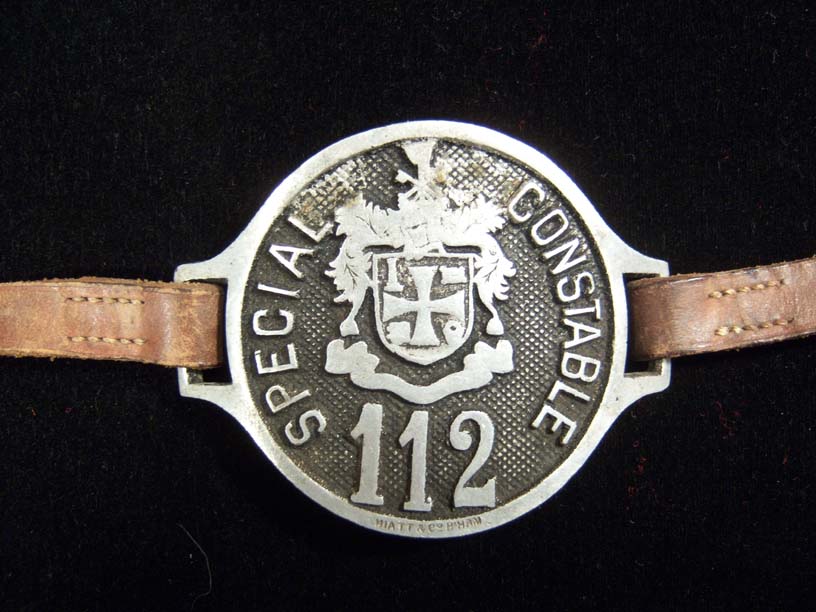 0
0 -
Nice cap, I have a Mid-Anglia one somewhere.
Purely a personal thing, but I've never liked voided badges showing the diced band behind, any voided badge I wore I backed with a small piece of black velvet (which does'nt mean I'm suggesting you stick one on that cap badge).
Leigh,
I can see what you are getting at, it would look a lot better and I shall make the change on mine.
Thanks for the tip.
Regards
Brian
0 -
Yes the band indicates it is for an Inspector or Chief Inspector. Most British police forces utilise the black braiding for Inspectors and then use silver for Superintendent ranks, although I have seen some Constabularies use the silver plain braiding for Inspectors. Merseyside is one I think.
Tom
Hi Tom,
Thanks for the conformation.
I was very happy to add this to my Staffordshire collection.
Regards
Brian
0 -
Hi Brain,
I dont know if this helps but i also have a medal with Ck who was also in the Punjab reg and i was told it was a clerk.
cheers
Chris
Hi Chris,
An expert on Indian ranks, both pre and post independence, on another forum has told me CK is cook.
Clerk wuld be CLK.
Looks like between us it's one for one regarding clerk or cook.
When it comes to India it seems nothing is simple.

Regards
Brian
0 -
Hello Stuart,
Everytime I see a new post on this thread I start from your original post and scroll through your collection.
I never tire of looking at it.
Thanks for providing so much enjoyment.
Regards
Brian
0 -
Brian,
It looks as if you've done a great job and I now know how to spot an Indian court mounted group too.
Tony
Thanks Tony.
Court mounting has become a side hobby of mine now and a couple of coworkers have asked that I court mount their father's medals. I'm going to have to retire just to have time for all of my hobbies.

Regards
Brian
0 -
Hi and Hugh,
Thanks for adding to the post.
I was hoping to see some ISO on this post as I don'r have any (yet).
Regards
Brian
0 -
This is the end result of the two styles. I think they both look good in their own way. I decided to mount Gen. Bucher's medal in the British style even though he was CinC of the Indian Army when he would have recieved it. It's a judgement call and I'm happy with it.
Thanks for taking a look at my post and a glimpse into my twisted world of court mounting.
Regards
Brian
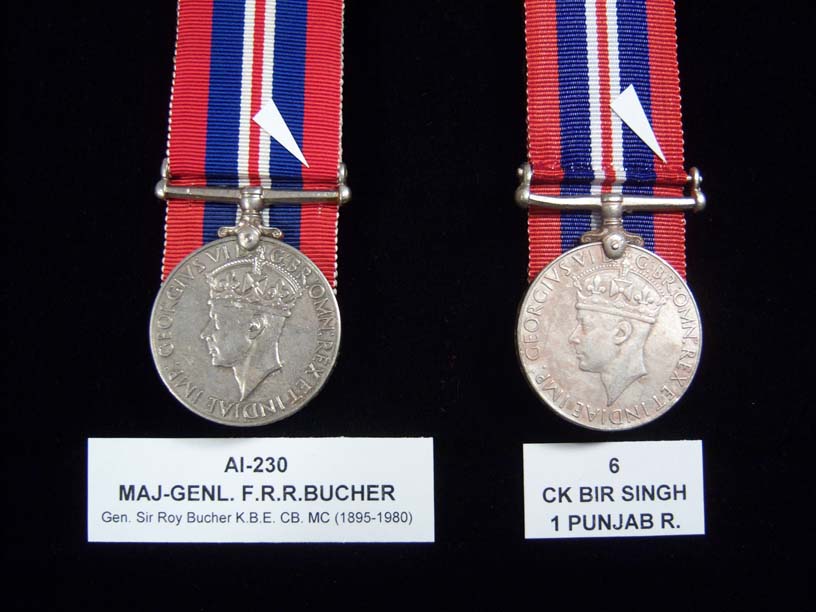 0
0 -
This is the sketch I drew up. I'm no draftsman but I hope it shows what I am trying to describe.
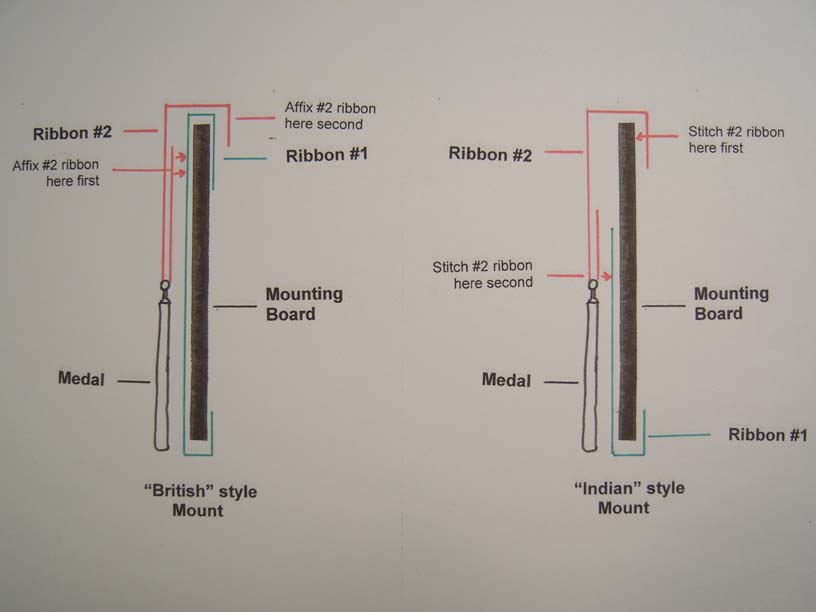 0
0 -
A few months ago I "won" a group of WWII Indian medals on the internet. These were court mounted and included the India Independence Medal which really appealed to me. I like groups of medals that "talk to me" and the era of the British Raj/Independent India has always intrigued me. When they arrived they were no longer court mounted but included the ribbons as they had been without the mounting board and the attachment pin. Needless to say I was disappointed somewhat as I like to add groups as they were worn though I do court mount a lot of groups that come to me loose.
I decided to follow the needle patterns in the ribbons and redo the court mount as it had been. My method is usually to use acid-free glue as well as some stitching with nylon (invisable) thread. This time, however, I would have to forgo the glue and try to become a real tailor. One of the errors, I will tell you right off, was that I misjudged the height of the mounting board, which I usually cut at 3 1/2 inches. I knew this one was shorter and settled for 3 inches. Two and one half would have probably been better. As I preceesed to copy the sewing, in most cases using the same needle holes, I started to get a better feel of the original tailor's work and the difficulty in producing a court mount with a minimum of ribbon. In what I will call the "British style" it is common to cover the mounting board with one piece of six inch ribbon and then using a second piece of six inch to mount the medal. I've included rough sketches below to try to illustrate this. In the case of the Indian Tailors the initial six inches of ribbon is all they use. This is cut and one piece (about 2 1/4 inches is afixed to the bottom of the mounting board and then the rest is used to mount the medal. It goes without saying that there is a need in India to conserve material if for no other reason than keeping the cost to the customer as low as possible. We are lucky here in the Western World to be able to be more extravagant.
One of the things that is evident when you look at a mount done in India and one done, say, in the UK is that there is stitching along the medal's mounting bar in the Indian method that is absent in the the "British style". You need to stitch along the bar in the Indian style in order to afix the ribbon and the medal to the mounting board. I hope this shows up in the sketch. The result is shown in the last photo of this post indicated by the little white arrow.
This has lead me to start to do a lot more stitch work on my mounts and use less ribbon to copy the Indian style more closely. I've always stitched along the medal's mounting bar to imitate the correct style but now I am trying to duplicate it accurately. The error on the part of the dealer has lead my to discover the original method used in India, it's almost like archaeology. Oh, the error in the height of the mounting board only resulted in some of the stitches having to be in a different location.
The first photo is of the completed group as it would have appeared when it was with it's original recipient.
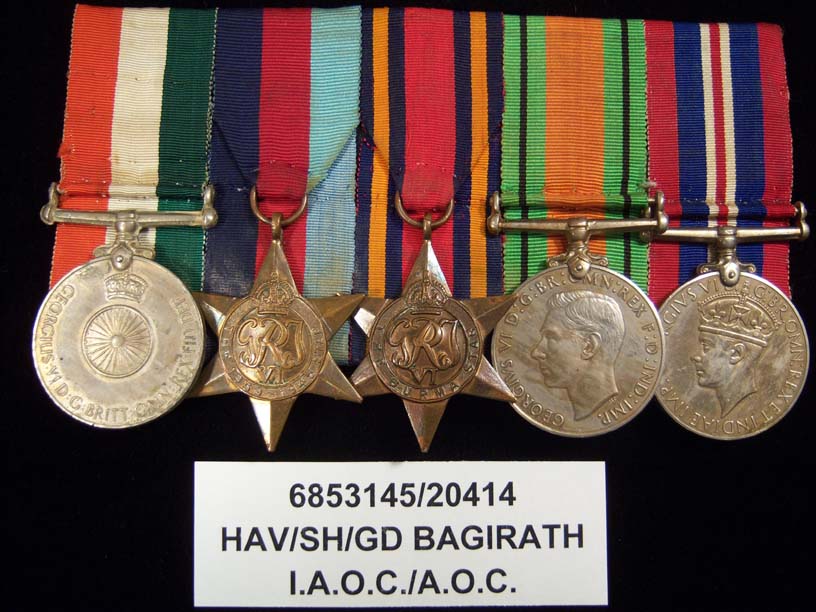 0
0 -
Hi Doc and Brian,
Thankyou both for tje info on court mounting.I had a look at both of them a while back.I am going to buy some card etc this week and have a go
 .I just hope i have plenty of ribbons
.I just hope i have plenty of ribbons .I shell post the results as i have about 30 groups to mount
.I shell post the results as i have about 30 groups to mount .If there any where i can get ribbons from for the post 1947 medals???
.If there any where i can get ribbons from for the post 1947 medals???regards
Chris
Hi Chris,
You have 30 to mount?!!! Man you must live in heaven.
I have been wanting to enter a post on the way the Indian Tailor's actually court mount using six inches (one piece) rather than using two pieces of six inch as I usually do. I'll get on it this evening and post it. I can't put it on this post as the medals are pre 47 and don't fit this post but the method is the same they are using today.
I will PM you a good source for medals as the dealer wishes to remain private.
Regards
Brian
0 -
Here is the obverse and reverse of my two George V Imperial Service Medals.
Thanks for looking.
As always if you have anything you would like to add to this post you are most welcomed.
Regards
Brian
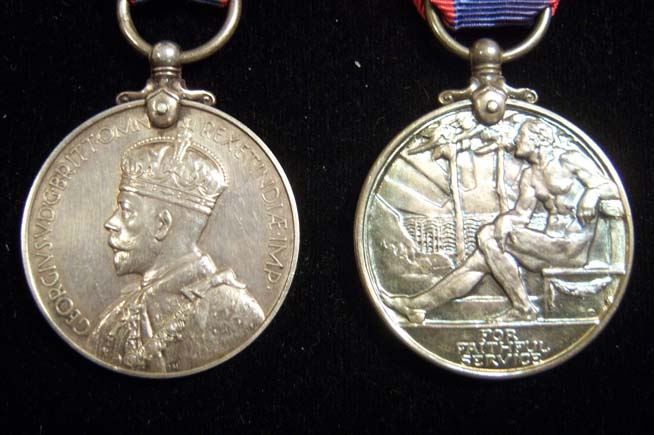 0
0




Special Constabulary
in Great Britain: Mervyn Mitton's British & Colonial Police Forces
Posted
Hi Tom,
That's the first one from Birmingham that I've seen.
Thanks for posting it, now I'll be on the watch for one.
Regards
Brian